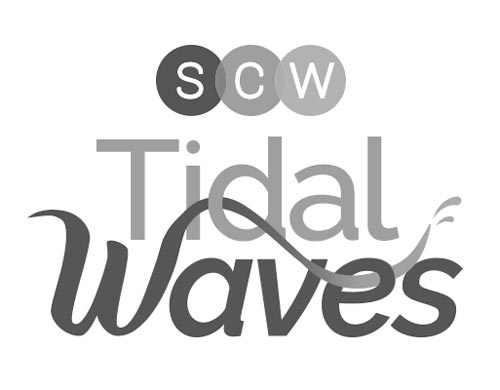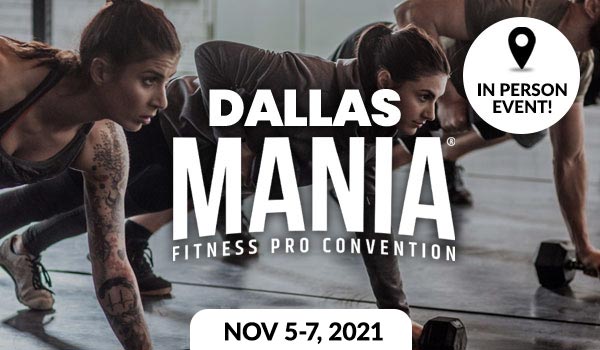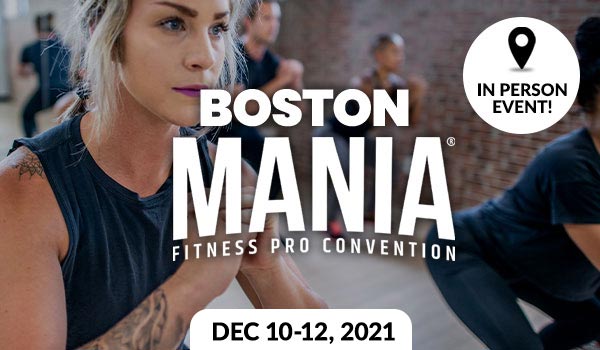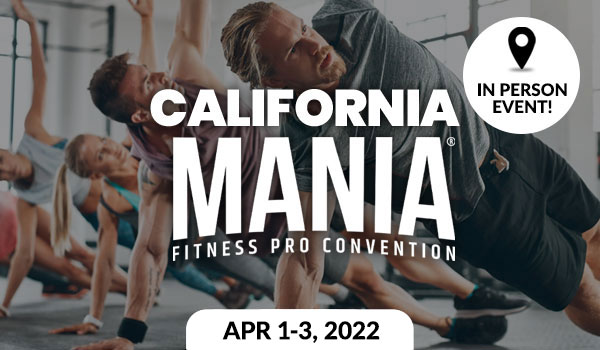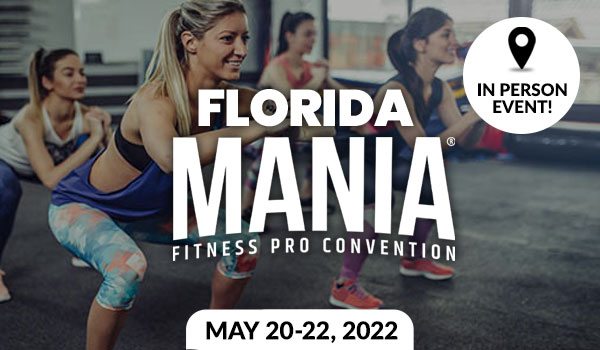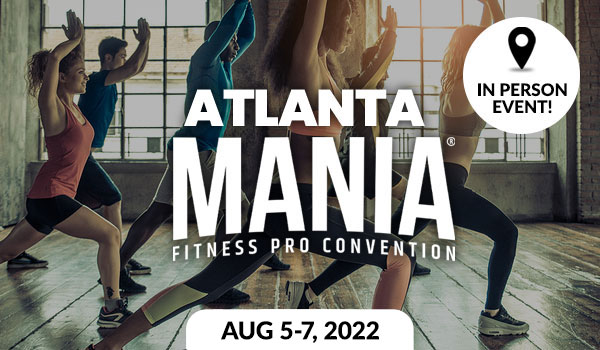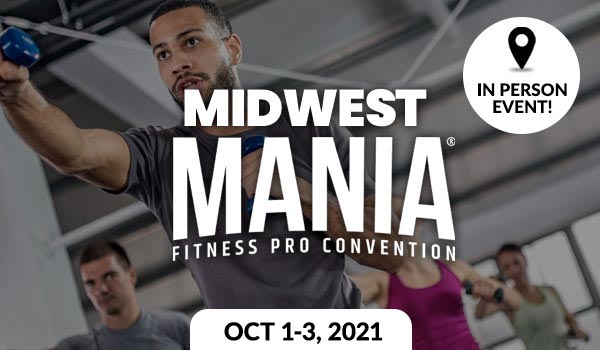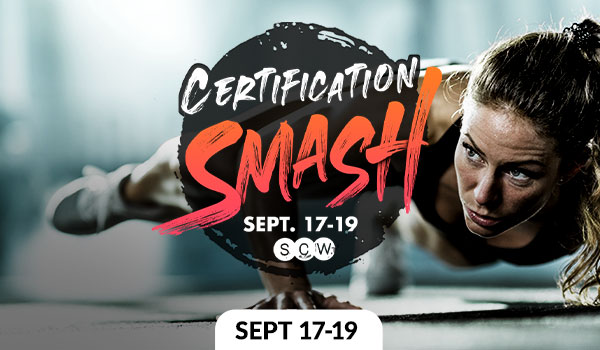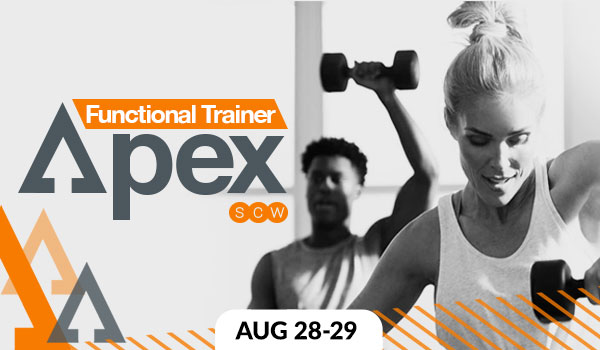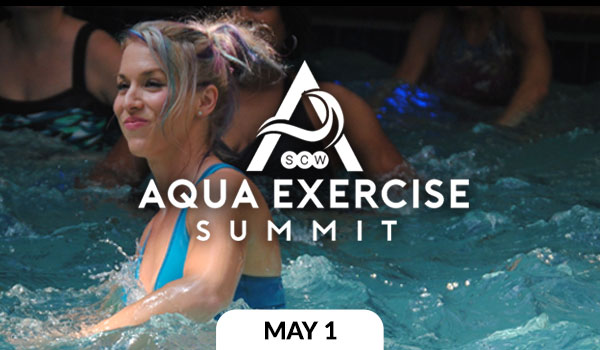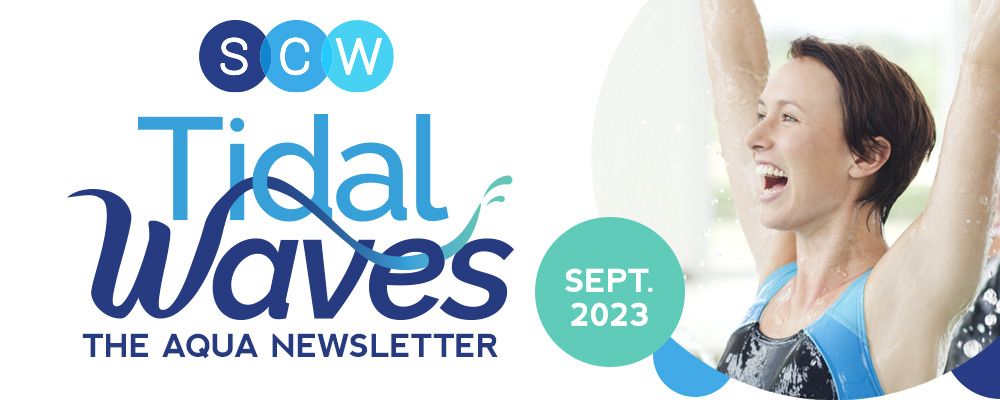
Lesson Planning:
Circuit & Interval Training
By Whitney Kessie, BA
Lesson plan is defined by the Lexico dictionary (n.d.) as “a teacher’s plan for teaching an individual lesson”. Laying out the workout plan, even if it is loose and flexible, gives the instructor an idea of where the workout is going. This can decrease the stress of presenting the material and leads to a better flow for the class. Be prepared and have a plan.
Before creating any type of workout, ask yourself, “What is the focus?” There are several options to consider, such as cardiorespiratory, strength or muscular endurance, flexibility, neuromotor exercise, or skill-related training (AEA 2018). When deciding on the focus, one, two, or even all five can be incorporated depending on the goal of the workout. It all comes down to the first question asked, “What is the focus?” Other considerations to keep in mind would be clientele, pool depth, and equipment.
There are numerous options for class formats, some are easier to freestyle than others. When it comes to intervals or circuit training, having it planned out in advanced is crucial for a smooth class. There are a couple tips and tricks that will aid in the planning process so as not to feel completely overwhelmed.
Typically, circuit training will involve multiple exercise stations where participants transition quickly from one to another with minimal rest. Circuits often involve stations spread throughout the pool, i.e. a self-guided option where individuals or small groups work together. Or, you may prefer to offer an instructor-guided option (which is easier to manage) or a combination circuit that blends both options. Circuits are a great way to utilize limited equipment. Having 20 people, but only 5 pieces of a specific equipment is not a problem when you spread your class out over 4-5 different stations. Circuits also do not need to be limited to high intensity classes; even with an arthritis-focused program, circuits are a fun way to mix it up.
Interval training is defined as hard bouts of work followed by easier bouts or recovery (AEA 2018). This can be as straightforward as performing one exercise for 30 seconds and taking 10 seconds rest then repeating. Or, for more interest or challenge, you can create patterns or blocks of work. Recovery can be passive, where participants do nothing, or active depending upon the intensity and duration of the work cycles. For active recovery, you can consider yoga poses, a Pilates move, walking, balance work, or an abdominal exercise. Interval training can also be adapted for a wide range of ability levels and interests, including arthritis programming, because the goal is for each individual to train at his/her appropriate level.
Helpful hint: circuit training is not limited to muscular conditioning and interval training is not limited to cardiorespiratory conditioning. Circuits often blend resistance training with cardio components, and interval training simply implies alternating intensities within the workout. For both formats, consider including muscular resistance (endurance, strength, power), cardiorespiratory (aerobic and/or anaerobic), flexibility, neuromuscular, or sport specific training. For example, incorporating yoga, Pilates or balance work as the recovery period allows for flexibility and neuromotor skills to be incorporated. Research shows that active recovery leads to better performance for the next round of high intensity work (Menzies et al. 2010). Both circuit and interval training can be short segments interspersed during the workout or the main segment of training. Additionally, the formats can be combined together in one training session.
When designing your workout, consider how much time will be spent at each station or exercise work cycle. For an anaerobic focus, you want short burst of high intensity exercises with longer rest or active recovery (Kraemer 2000). Exercises such as flutter kicks in the deep end, propelled or suspended cross-country skis, or rockets are just a few ideas. A couple options to consider when creating a workout would be one or two exercises for less than 2 minutes followed by a rest cycle, or work cycles lasting 20-30 seconds followed by 10-15 seconds of rest while repeating the cycle multiple times. For an aerobic focus, the work cycle will be longer than 2 minutes and the rest cycles will be fewer (Kraemer 2000). This is a great time to focus on long lever, powerful exercises such as straight leg kicks, cross-country legs with double arm pulls, or jack legs with chest fly arms, just to name a few. The energy systems can also be blended in a single session; try a long period of work divided into a couple interval bursts as a way to mix up the cardiovascular training.
As you decide how many circuits or how many patterns/segments to fill your allotted time, remember to leave 7-10 minutes for warm-up and 5-10 minutes for warm-down and stretching. Also, with circuits, if you plan to move from station to station around the pool versus completing each station together as a class, make sure to leave a couple minutes to explain each station and build in travel time as well.
The next step in your lesson plan is choosing exercises. Make sure all planes of movement – sagittal, frontal, and transverse – are incorporated. This will help to ensure a balanced workout hitting all, or at least most, of the major muscle groups (AEA 2018). This also helps to prevent overworking certain muscle groups while neglecting others.
Below are some examples that you may use or modify to meet the needs of your specific pool and participant interests.
- Aerobic Focus
6 minutes per station. 3 exercises performed for 3 rounds. First round: perform each exercise for 60 seconds. Second round: each exercise or 40 seconds. Third round: each exercise for 20 seconds. No rest between rounds.
Take 30 seconds to move to the next station.
Five different stations of your choice, such as cross-country ski with straight arm abduction & adduction in the transverse plane, jack legs with elbow flexion & extension in the sagittal plane, sumo legs with alternating presses in the frontal plane.
- Anaerobic Focus
8 stations with only 1 exercise at each station. 3 sets with 10 seconds work/5 seconds rest/15seconds work/5 seconds rest/20 seconds work/5 seconds rest.
Take 20-30 seconds to transition.
Fun exercises could be flutter kicks, jack legs with chest flies, cross-country ski (shallow propelled or deep with toes pointed/long lever), seated jack legs, cross press arms with grounded feet or with tire legs. Elevated or propelled exercises are also good choices such as shallow-water rocket or the deep-water option (2 sculls into 1 rocket: arms and legs out into jack position while sculling for 2-count, then propel body out of water by powering legs and arms together, engage the core as you return to wide jack starting position).
Perform once or take a 10-minute break (with group work such as abdominal conditioning or wall work or running) and then repeat a second time.
Combination
2 exercises at each station, 6-8 stations. First exercise is a long lever force-focused exercise for 60 seconds. Second exercise is a short lever speed-focused exercise for 10 seconds work/5 seconds rest repeated 3 times. Repeat 1-3 sets before moving to the next station.
An effective deep-water combination could be jack legs with internal/external shoulder rotation (first exercise) and elevated tire running (knees wide, pressing palms down to elevate body out of the water.)
Abs and Arms
Either 2 exercises per station (one upper body and one core) or alternate between upper body and core at each station. 45 seconds per exercise for either 3 rounds before rotating or perform only one round and go through the circuit 3 times. Optional use of equipment.
Here is a deep-water example. Abdominal Exercise: side scissor pike (kick both feet to the right in side-lying position; do two scissor kicks, feet stacked; pike center, reaching left arm to meet legs; kick legs to the other side and repeat.) Upper Body Exercise: seated position biceps-triceps (legs remain stationary; arms abducted; perform elbow flexion and extension.)
Upper-Lower Body Split
First exercise, legs remain stationary and just the arms work. Second exercise, arms remain stationary while just the legs work. If using upper body resistance equipment have participants have the equipment the entire time.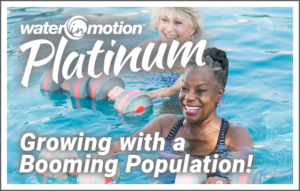
Pattern or Block
Repeat the following sequence of movements with a right side focus on active recovery segments. Repeat same exercise but change active recovery to left side. Take a 30-60 second walk or water break then repeat the training block with all new exercises; possibly an abduction/adduction focus to change the planes of movement.
TIME | EXERCISE |
60 seconds – hard work | Cross-country ski double arm pull |
20 seconds – active recovery | Right leg / pointed toe pulse in front of body |
40 seconds – hard work | Angled ski (45 degrees to 45 degrees) |
20 seconds – active recovery | Right leg / flexed foot side pulse |
20 seconds – hard work | Propelled ski (squeeze the legs together and propel off the bottom of the pool or out of the water if deep) |
20 seconds – active recovery | Right foot turned out approximately 45 degrees – grounded single leg cross-country |
These are just some suggestions and ideas to get the creative juices flowing. With circuits and intervals, the sky is the limit. Remember to start with answering, “What is the focus?” From there, using planes of movements work through the entire body. Do not be afraid to repeat a pattern or block while changing the exercises utilized. Have a plan, be prepared, and keep it simple.
RESOURCES
Aquatic Exercise Association. 2018. Aquatic Fitness Professional Manual (7th ed.) Champaign, IL: Human Kinetics.
Kraemer, W.J. 2000. Physiological Adaptations to Anaerobic and Aerobic Endurance Training Programs. From Essentials of Strength Training and Conditioning (pp. 137-168). Baechle, T.R. & Earle, R.W. Editors. Champaign, IL: Human Kinetics.
Lesson Plan. (n.d.). In Lexico powered by Oxford. Retrieved by https://www.lexico.com/definition/lesson_plan
Menzies, P., Menzies, C., McIntyre, L., Peterson, P., Wilson, J., & Kei, O.J. 2010. Blood lactate clearance during active recovery after an intense running bout depends on the intensity of the active recovery. Journal of Sport Sciences, 28(9), 975-982. doi: 10.1080/02640414.2010.481721.
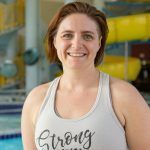 About the Author: Whitney Kessie
About the Author: Whitney Kessie
Whitney Kessie holds a degree in kinesiology and has diverse background in aquatics as a swim coach, training competitive athletes, and teaching group fitness. Currently she is an Aquatic Training Specialist and Relations Manager for AEA. She loves to challenge individuals to push themselves out of their comfort zone.
Follow us on IG: https://www.instagram.com/scwmania/
Like our FB page: https://www.facebook.com/scwmania
Follow us on X: https://twitter.com/scw_mania
Connect with us on LinkedIn: https://www.linkedin.com/company/scwfit/
Twice the Fun at MANIA®
Only two pools left for 2023, as we wind down our MANIA® season. Midwest MANIA®, September 29 – October 1 at the Westin O’Hare in Rosemont, IL, and Boston MANIA®, November 3-5 at the DoubleTree by Hilton in Danvers, MA. Register today and save $100 with code FALL, plus stay at the hotel, and attend Muscle Mastery FREE on Thursday evening. Learn the latest in aquatic research and choreography with 30 splashy live and recorded sessions and of course, upskill your portfolio with over 150 workshops and lectures in nine other realms of health, nutrition, fitness, and business education.
Follow us on IG: https://www.instagram.com/scwmania/
Like our FB page: https://www.facebook.com/scwmania
Follow us on X: https://twitter.com/scw_mania
Connect with us on LinkedIn: https://www.linkedin.com/company/scwfit/
How to Keep Natatorium
Air and Water Clean
by Michael Popke
Courtesy of Athleticbusiness
Misperceptions abound about indoor pools and outdoor pools. One of the biggest has to do with costs to build and operate.
“People think, ‘Oh, indoor pools aren’t that much more expensive than outdoor pools,” says Paul Stewart, vice president of sales, marketing and service at Desert Aire LLC, a supplier of commercial dehumidification systems. “Au contraire. They’re 10 to 15 times more expensive to build — and then you need to start talking about maintaining an indoor pool.”
While it’s true that both indoor and outdoor pools off-gas chloramines — chemicals such as dichloramine and trichloramine that form when chlorine binds with such human organics as urine and sweat — they scatter quickly in the air at outdoor facilities. Inside, it’s a different story.
Excessive chloramines in an indoor pool environment can lead to swimmer and spectator discomfort that includes such symptoms as itchy eyes, irritated skin and respiratory issues. What’s more, trichloramines — which can be up to three times heavier than air — “eat metal,” in the words of Mark Hines, vice president of sales and marketing for Paddock Pool Equipment Co., which manufactures an indoor air-quality system called the Evacuator®.
He references the collapse of indoor pool ductwork in May at the Gaylord Rockies Resort in Aurora, Colo., that injured several people, speculating as the culprit poor indoor air quality that deteriorated the metal over time. As of mid-summer, the incident appeared to still be under investigation.
“We’ve done a really good job explaining to architects what trichloramines are, and what not getting rid of this bad air does to the beautiful facility that they just built,” Hines says, adding that it’s worth foregoing “faux wood beams” in a project’s budget in favor of infrastructure that will “keep people healthy and keep a structure sound.”
If you’re operating an indoor pool, you must make the most of it — not only from a programming perspective, but also from a maintenance and upkeep standpoint. And just as an aquatic facility’s reputation rests on its indoor air quality, the quality of the pool water itself also impacts user experience.
“ ‘Water quality’ is an ambiguous term,” says Michael Walsh, executive chairman and founder of Natare Corporation, a commercial pool and equipment supplier. “Pool operators and the people who design and construct pools often have little understanding of what that really means. Seeing cloudy water and saying, ‘Okay, that’s poor-quality water’ doesn’t really define what’s causing the problem.”
Cloudy water can be caused, for example, by airborne particulates that end up in the pool, or by incorrect chemical settings. But other factors might be at play, too, which muddies matters considerably.
“It’s convenient to think, ‘I have a water chemistry controller, so now I don’t need to worry about water quality,’” says Brett Steinbrueck, president and co-founder of BECS Technology, which makes water chemistry and filtration controls. “But that is a very flawed and dangerous attitude. Water chemistry is complicated. We know that from high school chemistry class.”
You know what else is complicated? Keeping an entire indoor pool environment safe for everyone swimming in the water, standing on the deck and sitting in the stands. Here are some potential solutions to simplify this monumental task.
In the air
For decades, locker room signage asking pool users to shower before entering the water have proven all but worthless. Yet those signs carried the best of intentions.
“We can certainly try to convince [everyone] to shower before they get in the pool and get all the nasty stuff off their body, because that way there wouldn’t be as much chlorine having to treat the stuff that comes off of each person in the pool,” Stewart says. “But everybody thinks, ‘Why do I need to take a shower? I’m going to the pool.’ ”
“One person not taking a shower can affect the pool for nine days,” Mick Nelson, then the club facilities director for USA Swimming, told Swimming World after future U.S. Olympian gold medalist Caleb Dressel was hospitalized in the middle of the 2013 USA Swimming Winter Junior National Championships at the Greensboro Aquatic Center in North Carolina. Officials blamed poor indoor air quality at the facility, which has since been upgraded and is now considered one of the premier natatoriums in the country.
The old-school way of treating airborne chloramines was “solution by dilution,” Hines says. “Just keep increasing the amount of outdoor air that you bring into the facility, and it’ll dilute the indoor air and take care of everything. The truth is, it can’t do that — because the air still gets recirculated, unless you remove 100 percent of the air and put in 100 percent fresh air all the time. And even if you do that, the cost is astronomical.”
Plus, chloramines still travel through and eat away at mechanical systems, shortening their lifespans.
Enter Paddock’s Evacuator, a source-capture system that minimizes indoor chloramine levels by exhausting them out of an indoor pool facility. Evacuator technology works in conjunction with a facility’s air-handling system to remove chloramines from the air near the pool surface and prolong the life of the facility. Units can be retrofitted into a deck drain, benches or walls. For new construction, the Evacuator can be installed as a closed-source capture system in the pool gutter — the best location, according to Hines. (Paddock also makes a Chemical & Pump Room Evacuator designed as a one-size-fits-all solution for poorly ventilated chemical and pump rooms.)
Since its introduction more than a decade ago, the Evacuator’s cost has dropped to encourage more facilities to install the product, Hines says, adding that about 400 units are now in use across the country.
Desert Aire distributes the Evacuator bench system and manufactures the RecoverAire™ system, which works with the Evacuator bench (as well as gutter venting and deck venting systems) to remove chloramines and recover energy from the exhaust air to heat pool water.
“It’s the exhaust fan for sucking the air through the bench, recovering the energy from that exhaust air stream and moving it back to the pool,” Stewart says. “We look at how much air you need to move out of the exhaust … to be replaced by fresh air.”
A major key to ensuring safer indoor air quality in new facilities going forward, according to Hines, is to convey its importance (and intricacies) to architects, aquatic designers and local officials and leaders — such as school boards and city councils.
“My comment to architects, specifically, is, ‘Nobody knows when they walk into a beautiful new facility who the aquatic designer was or who the equipment supplier was. But they often know who designed the pool,’ ” Hines says, adding that Paddock offers “lunch and learn” sessions for architecture firms about the Evacuator. Those events also include tours of facilities that use the system as well as those that don’t, allowing architects to feel for themselves the differences in indoor air quality.
Unless a pool chemical is developed that can accomplish everything chlorine does but without the off-gassing, indoor air quality will always be an issue for pool operators. In the meantime, operators are encouraged to pay attention to user complaints about persistent coughing and irritation to eyes or skin. Likewise, metal fixtures and fittings that appear to be prematurely corroding could indicate an indoor air quality problem that should be addressed.
Keep this in mind, too: The busier a pool is, the greater the odds of it exhibiting poor indoor air quality.
In the water
While indoor air quality impacts everyone inside a pool facility, pool water quality affects people in the pool — those who represent the primary reason the pool exists in the first place.
“There is more known today about water quality and factors that lead to maintaining proper water quality than at probably any other time in the history of swimming pools,” Walsh says. “But at the same time, it’s a very complex science. In many cases, pool operators — and there’s another ambiguous term, because pool operators can range from degreed individuals who have a complete understanding of chemistry to someone who just got handed the job because he was available — are not the problem. They can only do what they are allowed to do within the funding limits they have.”
“A younger generation of pool operators is emerging and, in general, they are much more comfortable with technology and automation than the previous generation,” Steinbrueck adds, noting there are plenty of industry-wide and company-specific training and education opportunities available for pool operators. “However, they have less experience with water chemistry than those they’re taking over for. Many experienced operators have maintained water quality by hand at one point or another in their careers, and consequently understand the subtleties that go along with that.”
Walsh suggests that organizations developing a new indoor aquatics facility hire a certified pool operator early on and make that person part of the planning and design process.
“Think about it: You’re building a water space that will cost several million dollars; what amount are you allocating to understanding how you’re going to operate it?” he says. “The pool operator understands the equipment that’s available today and the cost-benefit aspects of it. They need to be as involved as possible as to what kind of equipment is being used in the construction or renovation of a facility. Unfortunately, oftentimes there’s no consensus between the operators, the specifiers and the contractors as to what’s right. And oftentimes it’s the pool operator who may be the most informed — even though they might be the last person hired. That’s kind of a tragedy.”
Walsh also recommends bringing in a representative of the local chemical supplier that likely will be contracted to deliver product to the new facility; after all, he reasons, it makes no sense to design a treatment system if the chemicals to keep the pool operating clear and smoothly aren’t available at the desired price.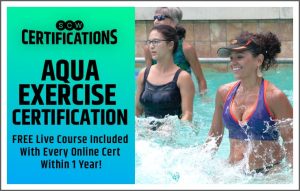
Natare manufactures the MicroFlo® vacuum sand filter. According to the company, its “uniquely designed flow-diversion screen and simplified operating controls take the guesswork out of high-volume water filtration, allowing easy access and a visual check during the filtration process.”
“It’s a filtration plant that does everything from minimizing the amount of water used and energy consumed to removing some of the smallest particulate matter of any filter on the market,” Walsh says, noting that it’s also the most expensive filter on the market but typically pays for itself within two to four years.
Meanwhile, BECS Technology offers several BECSys controllers, including BECSys Live — an online portal providing access to BECSys controllers from any PC or smartphone to allow real-time monitoring of water conditions. Users also can change settings, view historical graphs and run reports. When a controller goes into alarm mode, typically because a reading is outside an acceptable range, the controller can send an email or text message notification to programmed users, according to Steinbrueck.
“This allows operators and maintenance staff to immediately respond to problems while the situation is still reasonably manageable — much better than discovering a problem hours later on the next visit to the equipment room,” he says. “These are very powerful tools that really help today’s busy staff manage their time more effectively and also improve water quality, and they’re included with BECSys controllers.”
Steinbrueck also is noticing a trend toward increased automation, in large part because he says controllers do a better job maintaining water chemistry than manually hand-dosing chemicals. The chemistry controller continuously monitors water conditions and can feed chemicals as needed based on changes in demand. Other functions being automated into aquatics controllers, he adds, include alkalinity control, autofill, variable frequency drive control and filtration/backwash control.
As technology evolves and one generation of pool operators transitions to the next, it will remain imperative for facilities to maintain high air and water quality standards. Doing so will help establish competitive and recreational facilities as go-to destinations — ones where patrons both in and out of the pool can have comfortable and memorable experiences.
Says Stewart, “The people who can make a difference are the owners and operators who realize there is a solution.”
Vacuuming Your Pool
Robotic swimming pool cleaners are a godsend to most commercial pool facility operators. Even the man who introduced a pool vacuuming alternative will admit that.
“But what I’ve seen over the years is that a lot of people will get away from the robotics, because once they break down, where do you go?” says Guy Erlich, founder and owner of Water Tech Corp., which makes cordless, rechargeable vacuums for commercial pools. “You have this machine that’s the width of a desk that needs to be sent back someplace for service. If you visit commercial facilities, almost all of them have some type of robotic sitting in the equipment room because of some kind of breakdown.”
Indeed, portable battery-operated pool vacs like the Pool Blaster® and the Precision 2.0® from Water Tech and The Vac Daddy® plug-in model make removing debris from the pool on a consistent basis simple. What’s more, the vacuums can easily be operated by lifeguards.
“Lifeguards aren’t pool people,” says Matthew D’Aguanno, creator of The Vac Daddy, which is available with a vacuum-to-waste attachment that removes silt, algae and other fine debris. “If you hand The Vac Daddy to an 18-year-old lifeguard who has no mechanical understanding of inertia and priming pumps, they can simply plug this thing in and vacuum the bottom of the pool.”
D’Aguanno, who says he recently answered an open casting call for ABC’s “Shark Tank” to help bolster The Vac Daddy’s market presence, adds that floating cords in lengths of 60 and 90 feet are available for large commercial pools.
Erlich notes that portable vacuums can be used in tandem with robotic cleaners. “It’s a relatively inexpensive way to give operators another option for quick, easy and powerful cleaning,” he says.
Because, as D’Aguanno puts it, “Clear water with physical debris on the floor annoys people.”
 About the Author: Michael Popke
About the Author: Michael Popke
Michael Popke is a freelance writer based in Madison, Wis., and a former editor at AQUA and Athletic Business. He now owns Two Lakes Media (twolakesmedia.com) and has won awards for his writing.
Follow us on IG: https://www.instagram.com/scwmania/
Like our FB page: https://www.facebook.com/scwmania
Follow us on X: https://twitter.com/scw_mania
Connect with us on LinkedIn: https://www.linkedin.com/company/scwfit/
Nutrition + Movement = Healthy Lifestyle:
Nutrition Coaching Summit
Confused by nutrition social media posts? Not sure how much protein or carbs to eat? Learn the latest evidence-based nutrition research online Saturday, October 21, at SCW Nutrition Coaching Summit. 36 sessions, 26 Top Industry Presenters all for only $99. Elite nutrition education in a one-day summit wrapped up in a healthy package to optimize client health and wellness habits.
Follow us on IG: https://www.instagram.com/scwmania/
Like our FB page: https://www.facebook.com/scwmania
Follow us on X: https://twitter.com/scw_mania
Connect with us on LinkedIn: https://www.linkedin.com/company/scwfit/
Just Move
by Anthony Vennare
Courtesy of Fitt Insider
When it comes to exercise, every little bit counts.
Stuck in Place
The benefits of physical activity are almost endless.
Setting a healthy baseline, the CDC recommends 150 minutes of moderate-intensity physical activity and two days of strength training per week. But, most people don’t come close.
- More than 70% of US adults fail to meet the combined physical activity and strength training benchmark.
- 25.3% of Americans are completely sedentary, not completing any physical activity outside their job in the past month.
- Among high-income nations, 70% of future healthcare costs will be spent on illnesses caused by inactivity.
Complicating matters, as Big Pharma advances “miracle” weight loss prescriptions at a breakneck pace, 45% of all American adults say they’d be interested in taking them.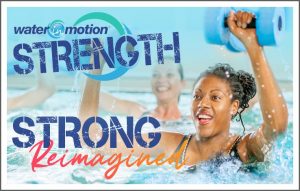
Simple science. While the search for a magic bullet continues, the not-so-secret solution may be right in front of us. According to longevity scientist Dr. Peter Attia, exercise is the “most potent drug” for improving health and longevity.
Adding complexity to sell solutions, fitness brands risk losing the plot — mainly that physical activity in all its forms has been shown to curb chronic diseases like obesity, hypertension, and diabetes but also cancer, depression, Alzheimer’s, and more.
Microdosing Fitness
Despite the many benefits, time remains one of the biggest barriers to exercise. But, it’s becoming more clear that even a few minutes of movement goes a long way.
- Just 3.4 minutes per day of vigorous lifestyle physical activity (like climbing stairs or fast walking) led to a ~17% decrease in cancer incidence; 4.5 minutes translated to ~31%.
- 30–60 minutes of strength training per week reduces all-cause mortality by 10–17%, with additional inverse links to CVD, diabetes, and some cancers.
- 20 minutes of physical activity yields a 43% drop in the risk of developing depression, while exercise was found to be 1.5x more effective than leading antidepressants.
Even the vaunted 10K steps per day rule is getting rolled back, with 2.3K steps improving heart health and 4K shown to reduce the risk of all-cause mortality.
Getting a boost, if employers encouraged their workforce to walk an extra 15 minutes per day (~2K steps), the global economy would gain $100B from improved productivity and life expectancy.
Hungry for results. Short on time and attention, many exercisers want bite-sized workouts that deliver fast results.
On the Fitt Insider Podcast, Hydrow CEO Bruce Smith spoke to the shift, saying: “There’s a hunger for things that are efficient. Time is the most valuable commodity we’ve got…”
While social media influencers, like Nike trainer Joe Holder, use short-form video to popularize “exercise snacks,” fitness brands are compressing workouts to keep time-strapped members engaged.
Among the many digital options, obé recently launched “stackable” 10-minute workouts, and Nike Training Club’s content partnership with Netflix produced ~30 high-efficiency HIIT classes, with more on the way.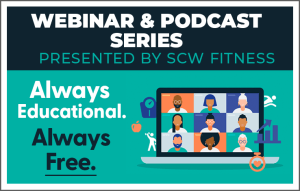
High-efficiency. Smashing the 45-minute benchmark set by brands like F45 Training, rowing workouts from connected equipment company Hydrow and studio concepts like Row House work 86% of the body’s muscles in a 20-minute workout.
All in on hyper-condensed 35-minute workouts, Self Esteem Brands is scaling its US-focused Basecamp Fitness franchise while launching SUMHIIT Fitness internationally.
TBD. It’s too soon to tell if efficacy and efficiency align, but franchise sales are stacking up for EMS studios like OHM and BODY20, continuous-resistance strength studios The Exercise Coach and fit20, and infrared sauna fitness concept Hotworx.
Meanwhile, biohacking-born Vasper is selling its systems to Bulletproof, Exos, and other optimization hubs.
Takeaway: Whether it’s walking more, exercise snacking, or prescribing exercise, any effort to promote physical activity is a step in the right direction — but it doesn’t have to be complicated. In the words of Harvard professor of evolutionary biology Dr. Daniel Lieberman: “Any movement is an improvement on none, more is usually better, and it is never too late to start.”
 About the Author: Anthony Vennare
About the Author: Anthony Vennare
Anthony is the CEO and founder of Fitt Insider and Fitt Capital along with his brother Joe. The Fitt Insider newsletter and podcast analyze industry headlines, trends and investment activity in the health, wellness, fitness & human performance business landscape.
Follow us on IG: https://www.instagram.com/scwmania/
Like our FB page: https://www.facebook.com/scwmania
Follow us on X: https://twitter.com/scw_mania
Connect with us on LinkedIn: https://www.linkedin.com/company/scwfit/
Are You a Winner?
EXTRA, EXTRA, READ ALL ABOUT IT!!!
SCW Fitness Education is excited to announce the latest winners for the WATERinMOTION® and S.E.A.T. (Supportive Exercise for Ageless Training) Fitness Enter-To-Win contest. These two specialized programs offer one-of-a-kind, pre-choreographed formatting for Aquatic and Active Aging exercise.
We’d like to recognize Sineyda Ortiz, the Assistant Director of Campus Recreation at the University of Texas – Arlington as the winner of a FREE WATERinMOTION® Online Certification. As the winner, Sineyda will have the knowledge to teach all three WATERinMOTION® formats; Original, Platinum, and Strength, along with the support and marketing needed to get the program licensed and splashing at UT-Arlington. CONGRATULATIONS SINEYDA!!!
The winner of the FREE Online S.E.A.T. Fitness Certification goes to Tammy Kershaw, a Studio Owner and Fitness Instructor in Connecticut. Being certified in S.E.A.T. Fitness will not only provide the skills needed to train active agers from head-to-toe, but it will also introduce an opportunity to those who may be hesitant to join a gym or take the first step in leading a healthy and active life.
CONGRATULATIONS TAMMY!!!
If you are interested in learning more about WATERinMOTION® or S.E.A.T. Fitness, please take a peek at these websites.
Feel free to reach out to us via a Zoom chat for more information about licensing these incredible programs: www.calendly.com/SCWFIT
You can also enter-to-win the next round of contests to be chosen in December. Thanks again to all those who entered and CONGRATULATIONS to Sineyda and Tammy.
Follow us on IG: https://www.instagram.com/scwmania/
Like our FB page: https://www.facebook.com/scwmania
Follow us on X: https://twitter.com/scw_mania
Connect with us on LinkedIn: https://www.linkedin.com/company/scwfit/
Looking To Hire? FREE Job Board
In Need of Teachers, Trainers, Directors, or Managers? SCW’s new FREE JOB BOARD is supporting the industry’s need for qualified fitness pros.
Best of all there is NO COST to you. We will post your openings in all three of our monthly e-newsletters: Spotlite, Health & Fitness Business News, and Tidal Waves which are emailed out to tens of thousands of fitness professionals teaching and training in all formats along with managers and directors at all fitness facilities: big box, gyms, boutique, studios, not for profits and independent centers.
Follow us on IG: https://www.instagram.com/scwmania/
Like our FB page: https://www.facebook.com/scwmania
Follow us on X: https://twitter.com/scw_mania
Connect with us on LinkedIn: https://www.linkedin.com/company/scwfit/
We’re always looking for great content highlighting the newest things in the world of aquatic fitness. Please submit your article directly to editor@scwfit.com for immediate consideration!
Give us your feedback on what interests you, and maybe YOU will make it in the SCW Tidal Waves!
Tidal Waves, January 2025
Tidal Waves, November 2024
Tidal Waves, October 2024
Tidal Waves, June 2024
Tidal Waves, May 2024
Tidal Waves, April 2024
Tidal Waves, March 2024
Tidal Waves, February 2024
Tidal Waves, January 2024
Tidal Waves, December 2023
Tidal Waves, November 2023
Tidal Waves, October 2023
Tidal Waves, September 2023
Tidal Waves, August 2023
Tidal Waves, July 2023
Tidal Waves, June 2023
Tidal Waves, May 2023
Tidal Waves, April 2023
Tidal Waves, March 2023
Tidal Waves, January 2023
Tidal Waves, November 2022
Tidal Waves, September 2022
Tidal Waves, July 2022
Tidal Waves, June 2022
Tidal Waves, May 2022
Tidal Waves, April 2022
Tidal Waves, March 2022
Tidal Waves, February 2022
Tidal Waves, January 2022
Tidal Waves, November 2021
Tidal Waves, October 2021
Tidal Waves, August 2021
Tidal Waves, July 2021
Tidal Waves, June 2021
Tidal Waves, May 2021
Tidal Waves, April 2021
Tidal Waves, March 2021
Tidal Waves, January 2021


